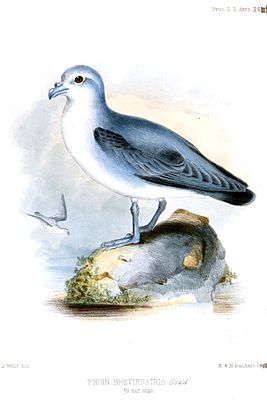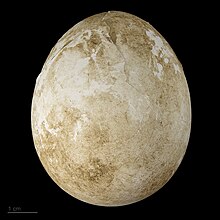Kerguelen petrel
| Kerguelen petrel | ||||||||||
|---|---|---|---|---|---|---|---|---|---|---|

Kerguelen petrel ( Aphrodroma brevirostris ) |
||||||||||
| Systematics | ||||||||||
|
||||||||||
| Scientific name of the genus | ||||||||||
| Aphrodroma | ||||||||||
| Olson, 2000 | ||||||||||
| Scientific name of the species | ||||||||||
| Aphrodroma brevirostris | ||||||||||
| ( Lesson , 1831) |
The Kerguelen Petrel ( Aphrodroma brevirostris , Syn. : Pterodroma brevirostris , Lugensa brevirostris ) is a species of the family of petrels . The species was separated from the hook shearwater genus and placed in its own monotypical genus Lugensa . It occurs circumpolar in sub-Antarctic and Antarctic regions. The IUCN classifies the kerguelen petrel as not endangered ( least concern ) and estimates the population at one million sexually mature individuals.
features
The Kerguelen petrel reaches a body length of 33 to 36 centimeters. The wingspan is 80 to 82 centimeters and the average weight is 357 grams. It is thus a medium-sized petrel, in which, like many other members of this family, there is no sexual dimorphism .
Kerguelen petrels are uniformly slate gray, the wing covers and the tail feathers are a little darker than the rest of the plumage. There is a black and gray spot around the eye. The underside of the body is uniformly slate gray and overall somewhat lighter than the upper side of the body. The black beak is short and strong. The iris is brown. The legs and feet are brown to gray-purple.
The Kerguelen Petrel can be confused with several other petrels. The long-winged petrel is significantly larger and darker than the Kerguelen petrel . The soft- feathered petrel is similar to the Kerguelen petrel in size and plumage color, but has a slightly different body shape and a different flight pattern. The soft-feathered petrel has a more rounded head and its wings appear shorter and wider. Unlike most petrels, the Kerguelen petrel often flies very high in the air.
Distribution area
The kerguelen petrel is an offshore bird that is rarely seen over land outside of the breeding season. It is relatively rare in the South Pacific, but it is observed in large numbers in the Tasman Sea during some winters . It breeds on sub-Antarctic islands in the Indian and Atlantic Oceans. The most famous brood islands include the Prince Edward Islands , Crozet Islands , Kerguelen , Tristan da Cunha and Gough Island . The breeding colonies on most of the breeding islands are very large, and house rats, feral dogs and cats are a potential threat to this species on the islands where they were introduced.
Way of life
The Kerguelen petrel eats cephalopods , fish and crustaceans, but so far there has not been sufficient research into what constitutes the main prey. The reproductive biology of this species has not yet been conclusively investigated either. They are colony breeders who are also easily associated with other petrel species. White-chin petrels and small duck petrels also occur in the main breeding colonies .
The breeding season falls from August to February. In general, non-breeding solitary birds also stay in the breeding colonies, but from August onwards the Kerguelen petrels gather again mainly in their habitual colonies. Kerguelen petrels use earthworks for their breeding business. The egg-laying takes place largely synchronized in the respective breeding colony, the clutch consists of only one egg. Both parent birds breed, the parent birds detach at intervals of several days. The incubation period is 49 days. Newly hatched chicks weigh an average of 52.4 grams and reach an average weight of 410 grams during the nestling period. The nestlings leave the burrow during the night when they fled. They are able to take off immediately and are not accompanied by the parent birds. So far there is no information about the age at which they mate or breed for the first time.
Studies on breeding success are only available for individual breeding colonies. On the Île de la Possession , part of the Crozet Islands, four chicks hatched from five eggs, but none of them fledged. On Marion Island , part of the Prince Edward Islands, 31 chicks hatched from 49 eggs and 24 fledglings fledged. Most of the losses on Marion Island were due to the parent birds giving up the clutch or young bird. Next introduced to the breeding islands mammals skuas the main predators of this kind. They eat eggs, chicks and adult Kerguelensturmvögel.
supporting documents
literature
- PJ Higgins (Ed.): Handbook of Australian, New Zealand & Antarctic Birds , Volume 1, Ratites to Ducks, Oxford University Press, Oxford 1990, ISBN 0195530683
Web links
- BirdLife factsheet on the Kerguelen Petrel
- Aphrodroma brevirostris inthe IUCN Red List of Threatened Species 2010.4. Posted by: BirdLife International, 2009. Retrieved June 15, 2011 ..
- Videos, photos and sound recordings of Kerguelen Petrel (Pterodroma brevirostris) in the Internet Bird Collection
